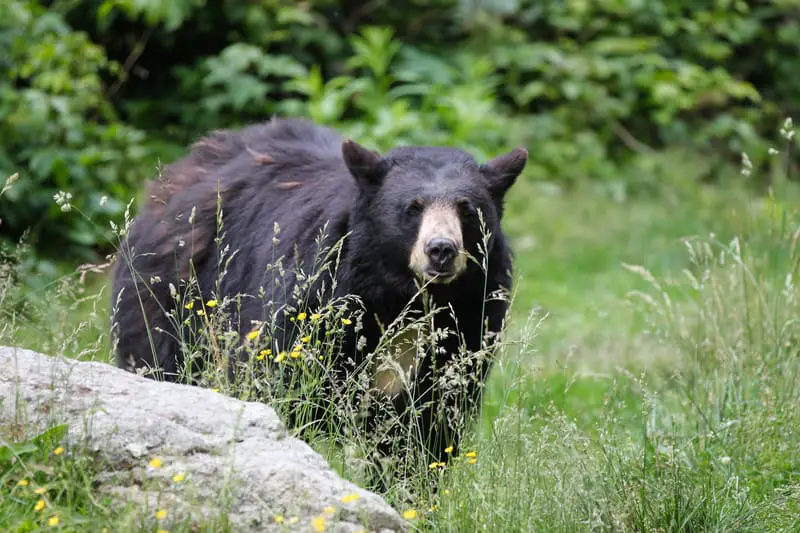According to the Nevada Department of Wildlife, the state is home to 400 to 700 American black bears at any given time. Bear populations fluctuate as the animals cross back and forth across the Nevada-California line and also the border with Oregon. Source
Nevada’s bears, both black bears and Grizzly bears, have a long history in the state. However, by the early 1900s, they were both eliminated from the state.
According to NDOW biologist Carl Lackey, bears historically roamed many of Nevada’s interior mountain ranges until the early 1900s. Through the examination of records and 19th-century newspaper articles, Lackey and his associates have determined that black bears and grizzly bears inhabited much of Nevada historically. However, conflicts with livestock ranchers, overhunting, and clear-cutting of timber, were all factors that contributed to the expatriation of bears from the state.
Today the western Nevada mountain ranges such as the Carson Range, Peavine Peak, the Pinenut Mountains, the Virginia Range, the Pine Grove Hills, the Wassuk Range, and the Sweetwater Mountains. hold the majority of the state’s black bear population. However, new subpopulations of black bears are beginning to reclaim parts of the historic range that their ancestors inhabited in central Nevada and eastern Nevada. Bear sightings are popping up in places like Ely, which is around 45 miles from the Utah line.
A genetic study
A study that was the result of a partnership between the Nevada Division of Wildlife and Geneticists at the University of Nevada, Reno, was recently completed.
The study was of bear hair and blood samples that have been collected over the last 20 years. It confirms a couple of things. One thing it indicates is that bears from the western Great Basin are colonizing east through central, eastern, and northern Nevada. The new study also concluded that the bear populations in the western ranges have enough genetic diversity to support the new populations that stem from them.
This study also makes the case for the protection of wildlife corridors through Nevada’s Great Basin. The animals need this to preserve a level of genetic connection. Nevada has a vast stretch of desert and various mountain ranges. Wildlife, including bears, need to be able to travel unimpeded in between various populations. See

Factors that affect Nevada’s bears
Urban bears are forced to adapt to the effects of human population growth
Increasingly in the Sierra Nevada range, for example, what is historical bear habitat, is being encroached upon by humans.
There are now around 40,000 year-round residents in the Lake Tahoe basin. What’s more, on peak days during the tourist season, the human population can shoot up to 300,000.
The bears either have to leave the area in search of territory that is less crowded with humans or adapt to their circumstances. The bears there have become increasingly habituated to humans.
For instance, Incline village is an unincorporated community in Washoe County on the north end of Lake Tahoe. Nuisance bears are an ongoing problem there. Bears break into people’s homes, garages, and vehicles. They also forage through unsecured trash containers for food.
This is a terrible situation for both bears and humans. Bears that become habituated to looking for food in urban areas lose the ability to take care of themselves in the wild. What’s more, if the bear perceives that a human is standing between it and its next meal, it may act out aggressively.
It also puts the professionals with the Nevada Department of Wildlife, whose job it is to manage the bears and minimize bear/ human conflicts, in a tough spot.
Bear crusaders
A lot of the people that move into areas like the Lake Tahoe Basin do so to escape the urban areas that they’re accustomed to.
Some of them bring idealistic yet unrealistic views and expectations about the natural world and their place within it. It also never seems to occur to them that their own presence is a disruption in the natural order of things.
Some of these people call themselves bear advocates. It must feel good to do so.
In the past, some of these so-called bear advocates in Incline Village have gone so far as to tamper with live traps set by the NDW to remove problem bears. See, This kind of behavior endangers everyone in the community. Human habituated bears sometimes injure or even kill people. See Also See Also See
All out-bear advocacy would be to mandate that all such communities in bear country revert back to their natural state. In other words, to de-populate them.
However, if you live in one of these bear country communities, you probably have no plans to leave. There are some less radical things you can do to make things more ideal.
- Number one is to keep your garbage in a bear-proof container such as a bear box. See
- You also need to keep your surroundings and vehicles free of any food residue.
- Thoroughly clean your barbecue grill and store it in a bear-proof building.
- Also, avoid feeding your outside pets more than they can clean up before dark.
- You also ought to think twice before putting a bird feeder in your yard.
- If you have a garden, orchard, or other outside food sources such as a chicken coop, use electric fencing.
If you live in one of these quasi-wilderness communities, you are probably there because you enjoy seeing wildlife. However, the bear that you see waddling down the street in broad daylight is not a bear in its natural state. The bear that raids your pantry for a jar of peanut butter isn’t a bear in its natural state, either. See
Be proactive and do your part to improve what is a less than an ideal situation for the bears. Also, instead of being an impediment to public safety, be courteous and cooperative to wildlife officers. They are doing their best to achieve the best outcome possible.
Note:” I don’t intend to single out Incline Village in particular. I searched for an example of a Nevada mountain community with bear conflict issues, and the most pertinent articles on the internet involved Incline Village. What’s more, the latest article I could find was from 2018. Conditions there in 2022, such as securing waste in bear-proof containers, might be vastly improved today.”
Forces of nature
Natural phenomena such as the climate have a great effect on Nevada bear populations. For instance, in drought years, some bears that would otherwise stay in the backcountry come to town looking for food. For instance, after three contiguous drought years culminating in 2014, the NDOW trapped 42 bears in urban areas. These bears came to such urban centers as Reno and Carson City in greater numbers than usual because they were looking for food. The berries and nuts that they depend on were in short supply due to the extended drought.
Fire and drought go hand in hand. Forest fires are the culmination of extended dry periods. They cause a temporary disruption in a bear’s food supply. However, if the fire is followed by a period of adequate moisture, the bear’s food sources will rebound in greater abundance.
The Caldor fire of 2021 was one of those disrupting events. Because of this disruption, more bears wandered onto highways and got hit by cars. It has also caused more bears to get themselves into trouble in urban areas. Ultimately though, if the eastern Sierras receive adequate moisture, the fire area will eventually produce more bear food than it did before the fire.

Highway crossings
Highways create barriers that are dangerous for animals to cross over. In 2021, an all-time high number of 46 bears were struck and killed on Nevada’s highways. The previous record was 35 in 2007. In 2022, as of September 22nd, 19 bears had been struck and killed on Nevada’s highways. For comparison, hunters harvested 14 Nevada bears in 2021.
According to Jon Beckmann, who is a conservation scientist employed by the Wildlife Conservation Society in Bozeman, Montana construction of wildlife-crossing structures is expensive. However, over time they pay for themselves in reduced wildlife mortality and fewer wildlife/traffic accidents.
The Nevada Transportation Department, in partnership with the Nevada Wildlife Department, has built a series of tunnels along with some bridges that cross U.S. Highway 93 north of Wells. They’ve also constructed a large passage over Interstate 80 west of Wendover.
Wyoming utilizes wildlife crossings. What’s more, the grizzly bears in Alberta’s Banff national park use them. See
Bear hunting in Nevada
For 2022 the Nevada Game Commission has set a quota of 45 resident and 5 non-resident bear tags. The total harvest limit for 2022 is 22 animals.
Below is a quote from the NDOW website that explains how the 2022 Nevada bear hunt will be conducted.
The hunt area is subdivided into three separate hunt unit groups to manage harvest with a concurrent
season, each with separate limits for the total harvest as well as female harvest. There will be a single
hunt application number for residents and another for non-residents, and tags will be valid for all hunt
areas. Portions of the hunting area may be closed as individual harvest limits are met, but all tags will
remain valid in the remaining open areas until all harvest limits are met or the season closing date is
reached.
Hunters or their guides must call the Nevada bear information hotline prior to hunting. This is to determine if the NDOW has closed the hunt or a specific area due to a harvest limit being reached.
For more complete information, see here.
You might also like the following:
Bonneville cutthroat trout in Nevada
Recent Posts
The only venomous snakes in Washington State are Northern Pacific Rattlesnakes. The Northern Pacific Rattlesnake (Crotalus oreganus oreganus) is a sub-species of the Western Rattlesnake. Anyone...
Skunks are not classified as true hibernators. But they go into a state of torpor when the weather gets cold. Skunks are light sleep hibernators, along with opossums, bears, and raccoons. ...

